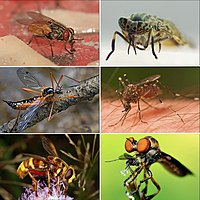
Photo from wikipedia
Parthenogenesis has been documented in almost every phylum of animals, and yet this phenomenon is largely understudied. It has particular importance in dipterans since some parthenogenetic species are also disease… Click to show full abstract
Parthenogenesis has been documented in almost every phylum of animals, and yet this phenomenon is largely understudied. It has particular importance in dipterans since some parthenogenetic species are also disease vectors and agricultural pests. Here, we present a catalogue of parthenogenetic dipterans, although it is likely that many more remain to be identified, and we discuss how their developmental biology and interactions with diverse environments may be linked to different types of parthenogenetic reproduction. We discuss how the advances in genetics and genomics have identified chromosomal loci associated with parthenogenesis. In particular, a polygenic cause of facultative parthenogenesis has been uncovered in Drosophila mercatorum, allowing the corresponding genetic variants to be tested for their ability to promote parthenogenesis in another species, Drosophila melanogaster. This study probably identifies just one of many routes that could be followed in the evolution of parthenogenesis. We attempt to account for why the phenomenon has evolved so many times in the dipteran order and why facultative parthenogenesis appears particularly prevalent. We also discuss the significance of coarse genomic changes, including non-disjunction, aneuploidy, and polyploidy and how, together with changes to specific genes, these might relate to both facultative and obligate parthenogenesis in dipterans and other parthenogenetic animals.
Journal Title: Proceedings of the Royal Society B: Biological Sciences
Year Published: 2023
Link to full text (if available)
Share on Social Media: Sign Up to like & get
recommendations!